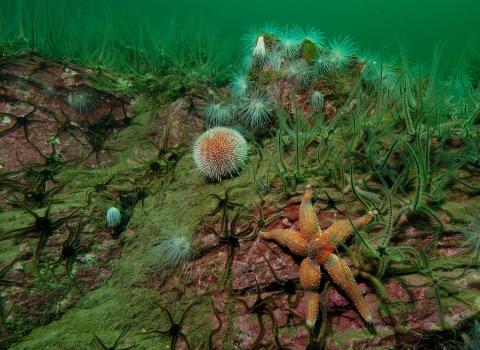What are Highly Protected Marine Areas?
Our seas are under pressure like never before; decades of over exploitation, pollution and unchecked development have resulted in continued biodiversity loss and a degradation of marine habitats. But there is a way to help bring our seas back to life!
Highly Protected Marine Areas (HPMAs) are a type of Marine Protected Area (MPA) which offer the strictest possible environmental protections.
That means that only non-damaging activities, such as swimming, kayaking and scuba diving, will be allowed. There can be no fishing, construction, digging, or similar. That means that these areas give nature the best chance of recovery. Our shallow seas, diverse seabeds and deep underwater canyons can be healthy, productive and full of life once more.
Sabellaira reef at Allonby Bay ©NWIFCA
Progress so far
Thanks to the campaigning of over 10,000 of our amazing supporters, the Government promised to designate Highly Protected Marine Areas in English Waters.
On World Oceans Day 2021, Defra announced it would begin the process for designating HPMAs by the end of 2022, setting an ambitious commitment to protect our seas. The Wildlife Trusts believe there is an overwhelming case for the designation of HPMAs across our seas which would see a ban on all damaging activities, offering the strictest possible protections for the marine environment and giving nature the best chance of recovery.
In Summer 2022 the Government announced five proposed HMPA sites and opened a twelve week public consultation process. We asked you to support our call on the Government to designate all five sites - and 17,000 of you added your support and personal comments. Thank you! We'll be watching the next steps with interest and will keep supporters updated.
Where are the proposed HMPAs?
- Allonby Bay, off the Cumbrian coast
- Inner Silver Pit South, in the southern North Sea
- Dolphin Head, in the English Channel
- North-East of Farnes Deep, in the northern North Sea
- Lindisfarne, off the Northumerland coast

Illustrative map of the proposed HMPAs @TheWildlifeTrusts
More about HPMAs
Find out more about what a HPMA is and why they are being designated
Why are HPMAs important?
We need to protect our seas. Overfishing, climate change, pollution and development have given us unhealthy seas.
But HPMAs could help to turn this around. They can help us tackle climate change by protecting and recovering habitats important in natural carbon cycles e.g. seagrass meadows that can capture carbon from the atmosphere up to 35 times faster than tropical rainforests!
The Government also has an aim of achieving a well-managed and ecologically coherent network of MPAs. Designating Highly Protected Marine Areas would significantly help to achieve that aim. Not only that, monitoring the recovery of those areas can then help us to determine how to appropriately manage the network of Marine Protected Areas in the future.
How are HPMAs different to existing marine protected areas?
Existing Marine Protected Areas (MPAs) are important designations, but often their purpose is just to maintain the current, often degraded state and a lack of stringent management means damaging activities continue within their boundaries. They also have a ‘protected feature approach’. This means they only protect certain species and habitats within their boundaries. In these areas, only some damaging activities are prevented and only in some locations.
But in Highly Protected Marine Areas, all damaging activities would be banned within the whole site. This new type of designation will allow nature to properly recover. HPMAs would set a high bar against which we can measure other protected areas.
What will HPMAs protect?
HPMAs will protect all wildlife within their boundaries through a ‘whole-site approach’. This means that the ecosystem, habitats and species, abiotic elements, and their supporting ecosystem functions and processes are all protected. If it is in the HPMA it will be protected! This includes the seabed, the water column and the sea surface.
How HMPAs came about: The Benyon Review
The Highly Protected Marine Area review was launched by the then Secretary of State, Michael Gove, on World Oceans Day 2019. The review’s advisory panel, including Joan Edwards, Director of Marine Conservation at The Wildlife Trusts and led by former MP Richard Benyon, were tasked ‘To recommend whether and how HPMAs could be introduced in areas of sea within the UK Government’s competence’. To gather evidence, information and views on HPMAs, a public consultation was conducted and a wide range of stakeholders were engaged through roundtables, meetings and site visits.
Last year, the Benyon review of Highly Protected Marine Areas (HPMAs) was published by Defra. The Wildlife Trusts backed its recommendations that HPMAs should be an essential part of the UK network for protection and recovery of the marine environment, and that the government should introduce HPMAs as soon as possible.
Pilot HMPA Selection Process
The UK Government committed to identify and designate pilot Highly Protected Marine Areas (HPMAs) in English waters by the end of 2022. Defra, JNCC, Natural England, Cefas, the Marine Management Organisation, the Association of Inshore Fisheries and Conservation Authorities, and the Environment Agency worked together, with stakeholders, to identify potential pilot sites.
Government identified five pilot HPMAs based on ecological, social and economic criteria, aiming to select sites that provide the maximum biodiversity benefits while seeking to also maximise associated benefits and minimise impacts to sea users. The Wildlife Trusts submitted third party proposals for sites based on the criteria:
1. Ecological importance
2. Naturalness, sensitivity and potential to recover
3. Ecosystem services
After considering third-party proposals, alongside areas they identified, Natural England and JNCC developed an initial list of potential sites and submitted them to Defra for further social and economic consideration. Defra and the MMO then applied social and economic criteria to help narrow down the list. This included, but was not limited to, understanding what economic activity occurs in potential sites and the scale and importance of that activity and site to local communities.
To find out more about the process visit the JNCC webpage here.

